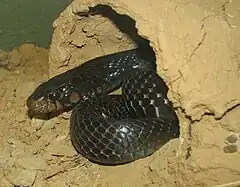| Drymarchon[1] | |||
| Fitzinger, 1843[2] | |||
 Przedstawiciel rodzaju – D. couperi | |||
| Systematyka | |||
| Domena | |||
|---|---|---|---|
| Królestwo | |||
| Typ | |||
| Podtyp | |||
| Gromada | |||
| Podgromada | |||
| Rząd | |||
| Podrząd | |||
| Infrarząd | |||
| Nadrodzina |
Colubroidea | ||
| Rodzina | |||
| Podrodzina | |||
| Rodzaj |
Drymarchon | ||
| Typ nomenklatoryczny | |||
|
Coluber corais Boie, 1827 | |||
| Synonimy | |||
| |||
| Gatunki | |||
| |||
Drymarchon – rodzaj węży z podrodziny Colubrinae w rodzinie połozowatych (Colubridae).
Zasięg występowania
Rodzaj obejmuje gatunki występujące w Stanach Zjednoczonych, Meksyku, Belize, Gwatemali, Hondurasie, Nikaragui, Kostaryce, Panamie, Kolumbii, Wenezueli, Gujanie Francuskiej, Brazylii, Ekwadorze, Boliwii, Peru, Paragwaju i Argentynie[6].
Systematyka
Etymologia
- Drymarchon: gr. δρυμος drumos „dąbrowa, knieja”[7]; αρχων arkhōn, αρχοντος arkhontos „władca, szef, monarcha”, od αρχω arkhō „rządzić”[8].
- Georgia: Georgia, Stany Zjednoczone[3]. Gatunek typowy: Coluber couperi Holbrook, 1842.
- Geoptyas: gr. γεω- geō- „ziemny-”, od γη gē „ziemia, grunt”[9]; πτυας ptuas, πτυαδος ptuados „gatunek żmii”[10]. Gatunek typowy: Geoptyas collaris Steindachner, 1867 (= Coluber corais Boie, 1827).
- Morenoa: prof. Aniceto Moreno[5]. Gatunek typowy: Morenoa orizabensis Dugès, 1905 (= Spilotes melanurus A.M.C. Duméril, Bibron & A.H.A. Duméril, 1854).
Podział systematyczny
Do rodzaju należą następujące gatunki[6]:
- Drymarchon caudomaculatus
- Drymarchon corais
- Drymarchon couperi
- Drymarchon kolpobasileus
- Drymarchon margaritae
- Drymarchon melanurus
Przypisy
- ↑ Drymarchon, [w:] Integrated Taxonomic Information System (ang.).
- ↑ L.J.F.J. Fitzinger: Systema reptilium. Fasciculus primus, Amblyglossae. Vindobonae: Braumüller et Seidel, 1843, s. 26. (łac.).
- 1 2 S.F. Baird & Ch.F. Girard: Catalogue of North American reptiles in the Museum of the Smithsonian institution. Cz. 1: Serpents. Washington: Smithsonian Institution, 1853, s. 92. (ang.).
- ↑ F. Steindachner. Herpetologische Notizen. „Sitzungsberichte der Kaiserlichen Akademie der Wissenschaften. Mathematisch-Naturwissenschaftliche Classe”. 55 (1), s. 271, 1867. (niem.).
- 1 2 A. Dugés. Description d’un Ophidien noaveau du Mexique (Morenoa orizabensis, g. et sp. nn.). „Proceedings of the Zoological Society of London”. 75 (2), s. 517, 1905. (fr.).
- 1 2 P. Uetz & J. Hallermann: Genus: Drymarchon. The Reptile Database. [dostęp 2019-03-22]. (ang.).
- ↑ Jaeger 1944 ↓, s. 76.
- ↑ Jaeger 1944 ↓, s. 21.
- ↑ Jaeger 1944 ↓, s. 95.
- ↑ Jaeger 1944 ↓, s. 188.
Bibliografia
- Edmund C. Jaeger, Source-book of biological names and terms, wyd. 1, Springfield: Charles C. Thomas, 1944, s. 1–256, OCLC 637083062 (ang.).
This article is issued from Wikipedia. The text is licensed under Creative Commons - Attribution - Sharealike. Additional terms may apply for the media files.